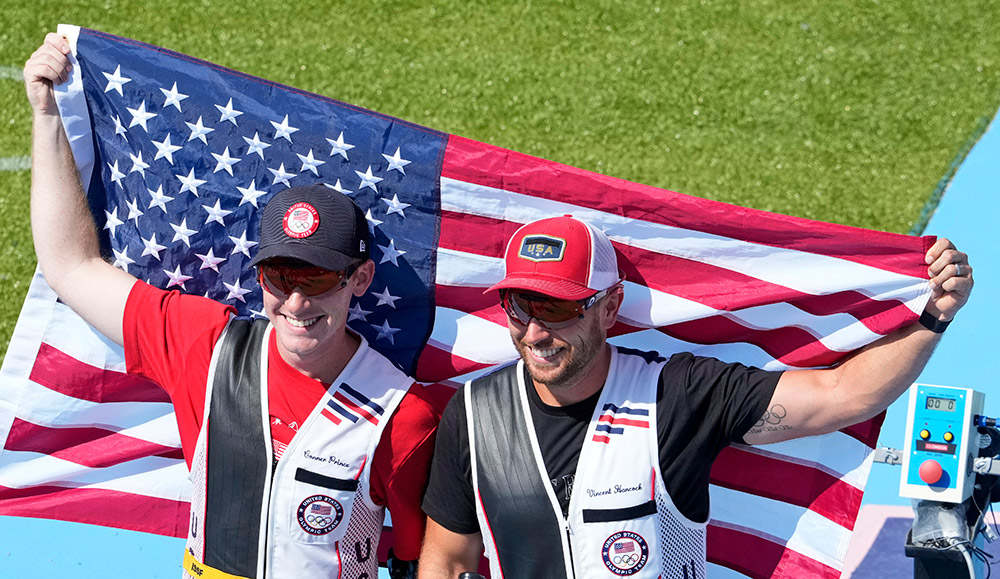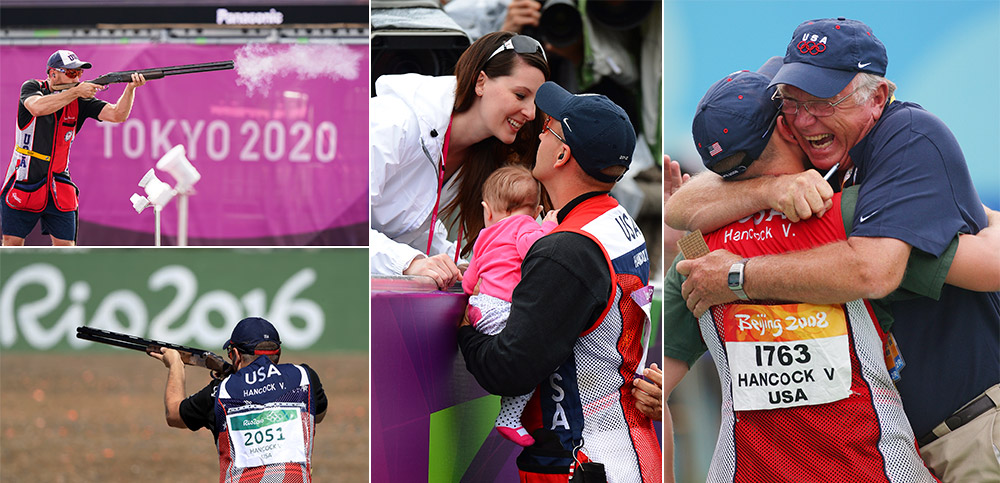
I don’t really see myself as a role model,” said four-time Olympic skeet gold medalist Vincent Hancock. “I just see myself as a guy who gets to do what he loves and that has the chance to be able to impact people in a positive way.”
I wasn’t so sure. In 2005, at age 16, Hancock won his first World Championship title in men’s skeet; additionally, he won the International Shooting Sport Federation’s Shooter of the Year award. He then spent the summer after his junior year in high school in the Army’s basic training and became a part of the U.S. Army Marksmanship Unit. Meanwhile, he kept winning World Championships and began winning Olympic medals. And he gives back. He is now the owner and president of Northlake Shooting Sports in Northlake, Texas. Over 400 high-school shooting athletes currently train at his facility every week. He hosts numerous youth shotgun competitions on the growing skeet and sporting clays range just outside of Dallas-Fort Worth and he personally coaches youth shooters.
As you’ll see, he also talks like a role model. But then, the fact that he isn’t willing to accept that appellation is perhaps what really shows he is one, as he knows it is not all about himself and his accomplishments; instead, he is walking his dream as he humbly helps the next generation use and appreciate their freedom. All of this made him a great pleasure to speak with and an honor to bring into these pages.
A1F: What’s it like working with so many young shooters?
Hancock: At my shooting range here at Northlake Shooting Sports, we have over 400 kids that practice here on a weekly basis. And we just held a really big youth shoot last weekend. We’ve got another one coming up in two weekends. So, we focus on trying to bring the shooting sports to people, whether that be kids on a high-school level or middle-school level, or just anybody who wants to come out and enjoy.
You know, that’s really what the goal is. I feel the shooting sports have given me a platform to be able to speak to people about the shooting sports, about what it can do across the entire globe, as well as just how much fun it really can be.
A1F: It was amazing to watch you competing in the Olympics in Paris last summer, but it was a bit hard to find. I ended up downloading the Peacock app in order to see the shooting events. What’s your experience with this? Do you feel like you and your sport are getting enough exposure from the mainstream press?
Hancock: They tried to do a better job this time. Obviously, they had us on Peacock, so every discipline was shown on Peacock this year, which is, again, a far cry better than what it’s been in the past. But I still think that, knowing that we had, in my individual event, myself as well as another guy going for a gold and silver at the very end, I would have thought they would have wanted to put that across the entire U.S. So, yes, I do wish that they would show us more, especially when we’re going for medals and especially when we’re going for an historic fourth gold.
When Katie Ledecky was doing the same thing in her sport that I did this year, she obviously had a lot more publicity than I could ever dream of. But for me, as long as my family got to watch, and I had my wife and daughters there, and then a bunch of people back here downloaded the Peacock app, so it was good.
So, I don’t really worry about it too much. I do wish that for the shooting sports we had more opportunity to be in front of people because the shooting sports are the safest sport in the world. And we have an opportunity to really show people the difference between our sport and a lot of the other sports and to show them just how fun it can really be.

A1F: I think you started competitive shooting when you were 11. And your father was a competitive shooter. What was your journey into this sport?
Hancock: I started when I was 10 and then I found the Olympic discipline when I was 12. I started American skeet just outside of Atlanta, Ga. And then I went quickly into sporting clays and just found a real passion for it. It was just so much fun. I always go back to that word: fun. And, you know, they say if you’re having fun doing what you love, then you never work a day in your life. Well, that’s kind of been the majority of my career.
So, at 12 years old, I went to the Atlanta range after being told that shooting was an Olympic sport, which my father and I didn’t know. And, on a Saturday, I shot my first rounds of Olympic skeet. I shot really well. I looked at my parents like, hey, this isn’t that hard. I can do this. And then I came back the next day, and I shot terribly. But on the drive home that night I told my parents this is what I want to do. I told them I wanted to go to the Olympics, and I wanted to win a gold medal.
And a few months later, my dad, who was in construction at the time, used some extra materials that he had from a few different job sites to construct a skeet field in our backyard. And that’s really where my official journey to the Olympics began.
A1F: One heck of a father, getting involved that way and seeing your potential. Or at least giving you a shot at it, as who knows what a kid’s potential is? And you served in the Army and were on the shooting team with the U.S. Army.
Hancock: Yep, I was in the Army Marksmanship Unit for six-and-a-half years. I joined in 2006, the summer of 2006, between my junior and senior years of high school. My parents had to sign off and allow me to do it because I had just turned 17. But I knew that if I wanted to make the 2008 team, and I wanted to join the army at the same time, that I was not going to be able to do it after I graduated from high school in 2007. So, they sent me off to basic training for the summer of ‘06. I missed my first week of my senior year of high school, but I came back.
As soon as I was done with high school, I went to the unit. I shot there for about four months, got through the first Olympic selection, and then they shipped me out to finish my Advanced Individual Training. After that, I shipped back to Fort Benning and was permanently duty stationed there with the Marksmanship Unit.

A1F: I’m seeing a role model here at every turn here. So, you’re in Texas now and you said you have 400 students per week to your range. Are these from local clubs and groups, or are they traveling to come and shoot with you?
Hancock: We’re in North Texas. We’re just north of Fort Worth. We’re like two miles away from Texas Motor Speedway. My business partner originally built this place. It was just a couple of skeet fields and a couple of trap fields put together for his son’s high-school team. And a couple of other high schools joined in, and when I met him about six months after he did that, I said, “Hey, here’s my vision.”
He agreed. We partnered up and pretty quickly thereafter, I put in a sporting clays course, put in more skeet fields. We’re actually putting in another one right now. So, in total now, we have three sporting clays courses, a five stand and about to be six trap-and-skeet fields.
We have all of these kids from local high school or middle school teams coming here to shoot. It’s all through a club level sport at school. We’re just trying to give them a place to be able to come out and do what they’ve found a passion for. This is similar to what I found whenever I was 10, 11, 12 years old. The hardest thing is finding a location. We have several clubs in the area, but the vast majority of them don’t have the space for kids.
A1F: What’s your process for keeping this safe and organized?
Hancock: So, for each one of the teams, their parents have to go through a coaching class. They need to keep a certain number of coaches on the line. That keeps them safe and gives them parental supervision.
Here at the club, we do have some coaches and obviously I do some coaching as well. But for the most part, these kids’ teams have their own coaches.
A1F: So, you’re helping coach as you walk around as a role model. I’m curious, over your competitive career have you seen the interest in the shooting sports grow?
Hancock: It’s growing faster than I’ve ever seen it. When I was young and going through the Scholastically Targeted Program, I went to the national championships. At the time, there were several hundred people there, which was a pretty big youth event. Now you have thousands of kids there competing at the national championships. Today, places like Wisconsin and Minnesota have 35,000 high-school students competing in leagues.
A1F: I’ve noticed it isn’t a certain body type that necessarily excels in the shooting sports. Someone who might not be athletic in football or baseball might do well in the shooting sports.
Hancock: Oh, absolutely. We see it all the time. Now while, yes, being a truly gifted athlete can help your progression, it’s not the end-all, be-all. I will never run fast enough or lift heavy enough or hit hard enough to be a professional baseball player or professional football player. But I can go out and work on perfecting my craft to break targets. That’s what we preach to these kids.
A1F: Do you deal with parents who are not gun owners and so maybe are unsure if their son or daughter should take part in the shooting sports?
Hancock: All the time. We have the chance to walk them through each step as they enter this culture. I’d never really experienced this until owning this range. I now see it as an opportunity to understand responsibility, to understand commitment and to understand what it takes to really be the kind of person you need to be on a daily basis. Because, if you’re going to own a gun, then you need to know that, yes, this gun can absolutely do bad things; however, it’s not meant for that. And so, you go through all of the safety training, and then those kids see it as a responsibility. That changes the parents’ experience. I can’t tell you how many people I’ve talked to who said, “The shooting sports have changed my child.”
They tell me that the shooting sports is the reason they have their child back because the child was going down a path that wasn’t good. And then, all of a sudden, because of this, they’re back on the right track.
A1F: Is there gamesmanship at a place like the Olympics? Are people getting in each other’s heads at all?
Hancock: I think that there are probably some people who try it. I know that there have been some people that tried it on me in the past, but what they don’t realize is that I really don’t care what anybody does. I’m totally oblivious most of the time to what’s going on around me because I’m focused on what I’m doing. And most of the time now, especially as I’ve gotten older, I’m not thinking about shooting unless I’m on the station. I just think about random things, because in the end, I need to be able to compartmentalize. I go in and out of that zone, the high-performance zone.
A1F: One last question: Given all you’re doing and all the growth we’re seeing in the shooting sports, are you hopeful about the future of our Second Amendment freedom?
Hancock: I think we need to continue to embrace the opportunity to impact people in a positive way from a shooting sports perspective. For me, I don’t dive off into trying to sway somebody’s mindset or to sway their belief. What I want to do is show them. I want to give them physical proof of what the shooting sports are really like, so they can then take that information and make a decision for themselves.
I’ve seen it so many times. We have members out here who rail against anybody who doesn’t understand gun ownership. But that approach just pushes away people.
If instead, we show them a community that’s willing to accept them and bring them in, we’re going to change minds. And I think that we can actually start to change the way that gun ownership and the shooting sports are seen in the U.S. It will start to change worldwide, too. I mean, in India, the shooting sports are the fastest-growing sport in the country. There are multiple countries where that’s the case. In the Middle East, it’s starting to grow and grow. It’s much more controlled over there from a gun-ownership perspective. But for us, we need to continue to embrace having more people coming in and to give them a reason to want to come back.


































